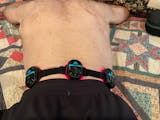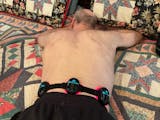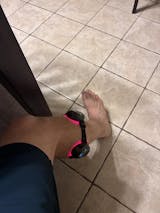Neck pain is something many of us deal with at some point, and it can significantly disrupt our ability to sleep. Whether it’s due to poor posture, stress, or an injury, finding a way to sleep comfortably with neck pain is crucial. This article will walk you through practical tips and tricks, including how
fda approved red light therapy devices for pain can help reduce pain and inflammation, promoting better sleep. Let’s dive into the best strategies for managing neck pain during sleep.
Understanding Neck Pain and Its Impact on Sleep
Common Causes of Neck Pain
Neck pain can stem from a variety of sources. Some of the most common causes are poor posture, muscle strain, or even sleeping in an awkward position. If you often wake up with neck pain, it might be due to how you're positioning your neck during sleep. It's also possible that your pillow or mattress may not be providing the right support.
How Neck Pain Affects Sleep
Neck pain can make it hard to find a comfortable sleeping position, often leading to restless nights. It can also disrupt your sleep cycle, causing you to wake up multiple times throughout the night. A lack of proper rest can worsen the pain, creating a cycle that's hard to break. This is why addressing neck pain before bedtime is so important for quality sleep.
The Role of Sleep Posture
Your sleeping posture plays a significant role in neck pain. Sleeping on your back or side with the right pillow can reduce pressure on your neck and spine, helping you sleep more comfortably. Sleeping on your stomach is typically the worst position for neck pain because it forces your neck into an unnatural twist.
Tips for Sleeping Comfortably with Neck Pain
Choose the Right Pillow
The right pillow is essential for supporting your neck and aligning your spine while you sleep. Look for a pillow that offers adequate neck support without being too high or too flat. Memory foam or orthopedic pillows are excellent choices, as they contour to the shape of your neck, providing consistent support throughout the night.
Sleeping Position Matters
When dealing with neck pain, sleeping on your back is often the best position. A pillow placed under your neck helps maintain its natural curve. If you're a side sleeper, make sure your pillow is thick enough to support the gap between your head and the mattress, keeping your spine aligned.
Use a Neck Roll for Extra Support
A neck roll is a simple yet effective tool for relieving neck pain while sleeping. Placing a neck roll under your neck helps support the natural curve of the cervical spine. It can reduce strain on the neck muscles and alleviate discomfort, making it easier to fall and stay asleep.
How Medical-Grade Red Light Therapy Can Help with Neck Pain
What is Medical-Grade Red Light Therapy?
FDA approved red light therapy uses specific wavelengths of red light to penetrate deep into your tissues. This therapy promotes healing by improving blood circulation and reducing inflammation in the affected areas. For neck pain sufferers, using a
red light therapy device - PRUNGO FluxGo can target pain points and help reduce muscle stiffness, leading to a more restful sleep.
Benefits of Red Light Therapy for Neck Pain
-
Reduces Inflammation: Helps decrease inflammation, a major cause of neck pain.
-
Stimulates Tissue Repair: Promotes faster healing of muscles and tissues.
-
Improves Circulation: Enhances blood flow, aiding in recovery and pain relief.
-
Alleviates Stiffness: Eases muscle stiffness, improving movement and comfort.
-
Non-invasive: Offers a natural, drug-free solution for chronic neck pain.
How to Use Medical-Grade Red Light Therapy Devices for Neck Pain Relief
Using medical-grade red light therapy devices for neck pain relief can be an effective, non-invasive method to alleviate discomfort. Here’s how to use them properly for maximum benefit:
-
Select the Right Device: Choose a medical-grade red light therapy device designed for pain relief. Ensure it emits wavelengths between 600–650 nanometers for optimal penetration into tissues.
-
Prepare the Area: Before using the device, ensure the neck area is clean and free of lotions or oils that could interfere with light absorption. You may want to remove any jewelry as well.
-
Position the Device Correctly: Place the red light therapy device close to the painful area. Most devices are handheld, so you can adjust it to cover the specific regions of your neck where the pain is most intense. If using a panel, position it at the appropriate distance as recommended by the manufacturer.
-
Set the Timer: Set the device to the recommended treatment time, usually between 10–20 minutes per session. Avoid overexposing the area, as this can cause discomfort or skin irritation.
-
Follow a Consistent Routine: For best results, use the device regularly, ideally 3–5 times a week. Consistency is key to reducing inflammation and promoting healing over time.
-
Monitor Progress: Keep track of your pain levels and adjust the frequency or duration of use as needed. If your pain persists or worsens, consult with a healthcare provider for further guidance.
By incorporating medical-grade red light therapy into your routine, you can experience effective, long-term relief from neck pain while enhancing tissue repair and reducing inflammation.
Creating the Ideal Sleep Environment for Neck Pain Relief
Keep Your Room Cool and Dark
A cool, dark environment is conducive to better sleep. Darkness helps stimulate melatonin production, which signals to your body that it’s time to rest. Keeping your room at a comfortable temperature—around 65°F (18°C)—can promote deeper, uninterrupted sleep.
Use a Firm Mattress
A firm mattress is crucial for supporting your back and neck while you sleep. A mattress that's too soft may allow your body to sink in too deeply, misaligning your spine. On the other hand, a mattress that's too firm can put unnecessary pressure on certain areas, exacerbating neck pain. Find a mattress that supports natural spinal alignment.
Avoid Bright Screens Before Bed
The blue light emitted by screens can disrupt your sleep cycle by interfering with melatonin production. Try to avoid using phones, tablets, or computers at least 30 minutes before bed. Instead, create a calming pre-sleep routine, such as reading a book or practicing relaxation exercises, to help your body unwind.
How to Incorporate Stretching and Relaxation Techniques
Gentle Neck Stretches Before Bed
Before lying down, consider doing gentle neck stretches. Slow, controlled movements can help relieve tension in the muscles around your neck and shoulders, reducing discomfort before you sleep. Focus on stretching your neck in all directions—forward, backward, and side to side—while avoiding any jerky motions.
Practice Deep Breathing and Relaxation
Deep breathing exercises help relax your body and mind, promoting better sleep. Take slow, deep breaths in through your nose and out through your mouth. You can pair this with progressive muscle relaxation to release tension from your neck and shoulders, creating a calm state that prepares you for sleep.
Consider Yoga for Neck Pain Relief
Yoga is an excellent way to improve flexibility and reduce neck pain. Poses like Child’s Pose, Cat-Cow, and Downward Dog can help release tension in the neck, shoulders, and spine. Practicing yoga regularly can not only help with sleep but also improve overall neck health.
Other Therapies to Support Neck Pain Relief During Sleep
Heat Therapy for Neck Pain
Applying a heating pad or warm compress to your neck before bed can help loosen up tight muscles and increase blood circulation. Heat therapy can provide immediate relief, making it easier to fall asleep without neck discomfort.
Cold Therapy for Neck Pain
For acute neck pain or inflammation, cold therapy is a great option. Use an ice pack wrapped in a cloth and apply it to the painful area for 15-20 minutes. Cold therapy helps numb the pain and reduce swelling, making it easier to sleep through the night.
Massage Therapy for Neck Pain Relief
A gentle neck massage before bed can help relax the muscles and improve blood flow to the area. This can significantly reduce neck stiffness and discomfort, allowing you to sleep more soundly. Consider using a handheld massager or booking a professional massage to target specific areas of pain.
Conclusion
Neck pain often affects sleep quality, but taking the right approach can significantly relieve symptoms and help you get better rest. Besides choosing a suitable pillow and adjusting your sleeping position, using a medical-grade red light therapy device is also an effective way to relieve pain. You can also try stretching, hot and cold therapy, and creating a comfortable sleep environment. For cases requiring extensive treatment, a
red light therapy panel is ideal; while a
red light therapy mask is more suitable for facial care, effectively covering multiple facial areas, and is particularly effective for anti-aging, soothing, and repairing, helping to improve skin health.




















Share:
Why Does My Lower Back Hurt
What Is the Fastest Way to Relieve Knee Pain